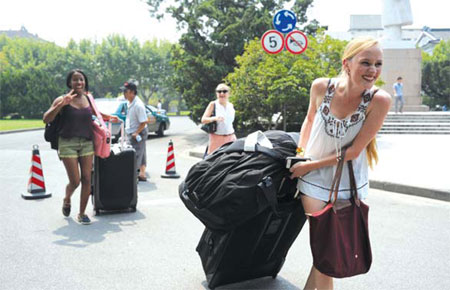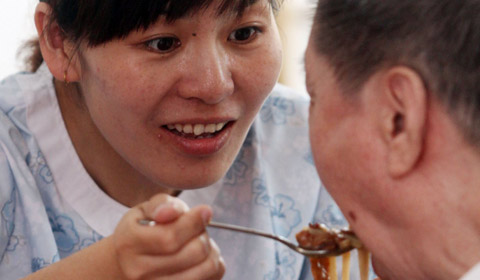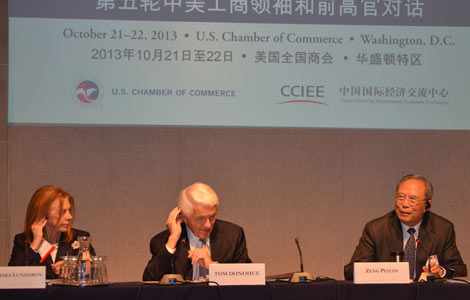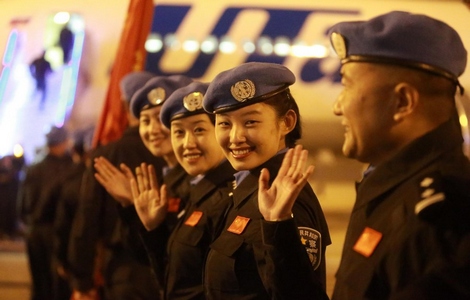Shanghai boosts education services with new class acts
Updated: 2013-10-24 07:11
By Wang Hongyi in Shanghai (China Daily)
|
||||||||
Shanghai, arguably China's most energetic commercial hub, is sparing no effort in becoming an international education exchange center and one of Asia's most popular study destinations, city officials say.
"We want to build an international education city full of diverse culture attractions," said Yang Weiren, who works in international exchange and cooperation for the Shanghai Education Commission.
"This will not only improve Chinese students' understanding of the world and increase their ability to communicate with the world, but it will also help attract more international students here," he said.
Yang revealed that the city is working on becoming a cosmopolitan education city through seeking out international cooperation and establishing a series of high-level international schools, ranging from high schools to vocational schools and universities.
The latest step is the first China-US high school, co-established by Shanghai Qibao High and Dwight School in the United States.
The three-year boarding school will be open to Chinese and overseas students, and the first batch of 100 students will be enrolled in the fall of 2014, the school said.
"Students at Shanghai Qibao Dwight High School will be taught bilingually," said its president, Qiu Zhonghai. "The school will also adopt a credits system."
Courses will combine Western sciences and traditional Chinese education.
At the same time, the school will introduce the International Baccalaureate Diploma Program, which provides students aged 16 to 19 with the internationally accepted qualification for entry into higher education, recognized by many universities worldwide.
Overseas focus
The school is also part of the city's move in recent years to develop high-level cooperative high school education.
According to a development plan for 2011 to 2015, released last year by the Shanghai Education Commission, the city encourages its quality high schools to establish cooperation with overseas education bodies, schools and groups.
"We want to establish one to two China-overseas cooperative high schools," Yang said, referring to the five-year plan.
"Schools in Britain, Australia and Canada are all in our vision, but we pay more attention to their quality and performance, which may help drive the improvement of Shanghai's education level."
Last year, Shanghai New York University was founded as China's first China-US university as an independent legal entity, operated by New York University and Shanghai's East China Normal University.
Its model of education and international courses has drawn attention from Chinese students and education experts. This year, about 500 Chinese students took part in the first round of admission interviews, with 151 eventually accepted.
The city is also encouraging universities to carry out more high-caliber programs with overseas institutes.
In 2006, Shanghai Jiao Tong University and the University of Michigan announced a joint venture to cultivate mechanical engineering expertise. It is one of the first international higher education institutes in China modeled after top US research universities in terms of academic environment, faculty quality, research opportunities and educational program guidelines.
The course systems were based on the University of Michigan system, joint bilingual teaching by Chinese and foreign teachers, mutual recognition of academic credits, and an innovative education system adapted to the global environment and its graduates.
The cooperative program has proved to be a great success and has also been recognized as an innovative model of China-US collaborative education for training world-class talent.
"The cooperation program was a successful example of promoting China's higher education development and talents' training," education official Yang said.
Hua Ouyang is a professor at Shanghai Jiao Tong University's School of Mechanical Engineering and taught in a cooperative program between the university and the US' Purdue University.
"The joint-teaching mode is beneficial; different culture, different thinking modes," he said, adding that combined education methods help both foreign and Chinese students learn more from each other.
Education goal
The next step for the city's education authorities, according to Yang, is to establish a cooperative vocational school. The education commission is looking for qualified international bodies for cooperation, he said.
Shanghai has more than 220 China-overseas cooperative education bodies and programs. It plans to add another 40 by 2015.
"We don't want to expand quickly. Our goal is to create fine education," Yang said.
The number of international students in the city has been rising. Last year, about 51,000 overseas students were studying in Shanghai, most from South Korea, Japan and the US.
City authorities hope that number will increase to 70,000, about 40 percent, by 2015.
In recent years, the city has announced a series of favorable policies and scholarships to encourage more outstanding foreign students to study at its universities.
Shanghai has been offering scholarships to international students since 2005, and more than 25 million yuan ($4 million) is granted to students each year, Yang said.
According to a Shanghai Education Commission development plan, the city will establish a comprehensive scholarship system to attract outstanding students. "Only a third of foreign students in Shanghai are in long-term degree programs," Yang explained. "We hope more outstanding foreign students can study for longer education programs, which last more than half a year."
This year, the commission set up a website - study-shanghai.org - in Chinese, English, Japanese and Korean for international students to apply for government scholarships.
The website also provides information about summer school courses, open classes, lectures and international exchange programs, as well as information about the city.
"Living in Shanghai is very easy for foreigners because of how developed and well-planned the city is," said Derek Tan, an international exchange student from Purdue University.
He finished his spring semester at Shanghai Jiao Tong University's School of Mechanical Engineering in May.
"There are many small differences between Chinese and American culture. There aren't any glaring differences that make life difficult - the difficulty comes from the combination of small differences," Tan said. "These are not things that can be taught in the classroom and are part of what makes the experience in China such a good one."
wanghongyi@chinadaily.com.cn
|
Two freshmen arrive at the Shanghai New York University in August to start their first semester at the China-US university, along with about 300 students from 40 countries. Liu Xiaojing / for China Daily |
(China Daily USA 10/24/2013 page6)
Most Viewed
Editor's Picks
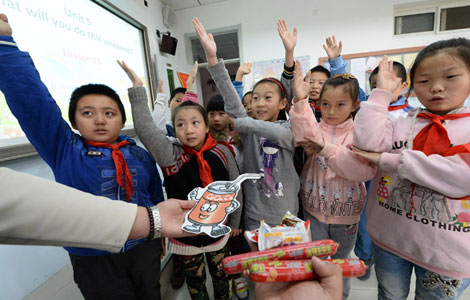
|

|

|

|

|

|
Today's Top News
Walmart China strategy: 110 new stores
China's GDP growth to 7.6%: Standard Chartered
Scholar looks at the kung fu-hip hop connection
Mobile giants talk future in Frisco
Starbucks' pricing furor: tempest in a coffee pot
100,000 Strong student exchange picks first partners
Report: China could profit rebuilding US
Holiday may boost sales of new iPads
US Weekly

|

|
